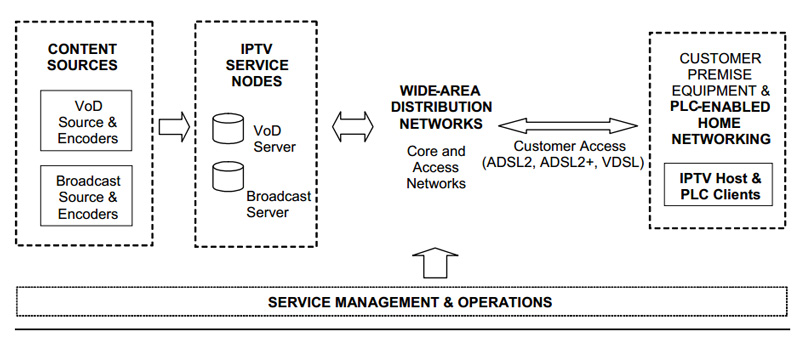Internet Protocol Television (IPTV) is a rapidly maturing technology for the delivery of broadcast TV and other media-rich services over a secure, end-to-end operator managed broadband IP data network. IPTV broadly encompasses a rich functionality that ranges from the acquisition, encoding and decoding, access control and management of video content, to the delivery of digital TV, movies on demand, viewing of stored programming, personalized program guides, and a host of interactive and multimedia services.
The following figure illustrates a generic IPTV system architecture to support applications such as digital (broadcast) television and Video on Demand (VoD). This architecture is based on the comprehensive architecture and services model specified in ITU Recommendation H.610 and on the IPTV platform offered by industry leaders such as Microsoft® Corporation. The generic IPTV architecture is utilized in this paper as a baseline reference to discuss IPTV distribution in-home networks.
The major functional components of the IPTV architecture are:
Content Sources – ‘Content Sources’ represents a functionality that receives video content from producers, and other sources, encodes the content and, for VoD, stores content in an acquisition database.
Service Nodes – The ‘Service Nodes’ represents a functionality that receives video streams in various formats, then reformats and encapsulates them for transmission with appropriate Quality of Service (QoS) indications to the wide-area network for delivery to customers. Service Nodes communicate with the Customer Premises Equipment (CPE) for service management and with the IPTV service for the subscriber, session and digital rights management. Service Nodes may be centralized or distributed in a metro area (e.g. at the Central Offices).
Wide Area Distribution Networks – This provides the distribution capability, capacity, quality of service and other capabilities, such as multicast, necessary for the reliable and timely distribution of IPTV data streams from the Service Nodes to the Customer Premises. The Core and Access Networks include the optical distribution backbone network and the various Digital Subscriber Line Access Multiplexers (DSLAMs) located at the central office or remote distribution points.
Customer Access Links – Customer delivery of IPTV is provided over the existing loop plant and the phone lines to homes using the higher-speed DSL technologies such as ADSL2+ and VDSL. The distance limitations and bandwidths attainable for these DSL technologies are summarized in Table 1. Service providers may use a combination of Fiber-to-the Curb (FTTC) and DSL technologies or implement direct Fiber-to-the-Home (FTTH) access depending on the richness of their IPTV service offerings.
Customer Premises Equipment (CPE) – In the IPTV context, the CPE device located at the customer premise provides the broadband network termination (B-NT) functionality at a minimum, and may include other integrated functions such as routing gateway, set-top box and home networking capabilities.
IPTV Client – The IPTV Client is the functional unit, which terminates the IPTV traffic at the customer premises. This is a device, such as a set-top box, that performs the functional processing, which includes setting up the connection and QoS with the Service Node, decoding the video streams, channel change functionality, user display control, and connections to user appliances such as a standard-definition TV or HDTV monitors.